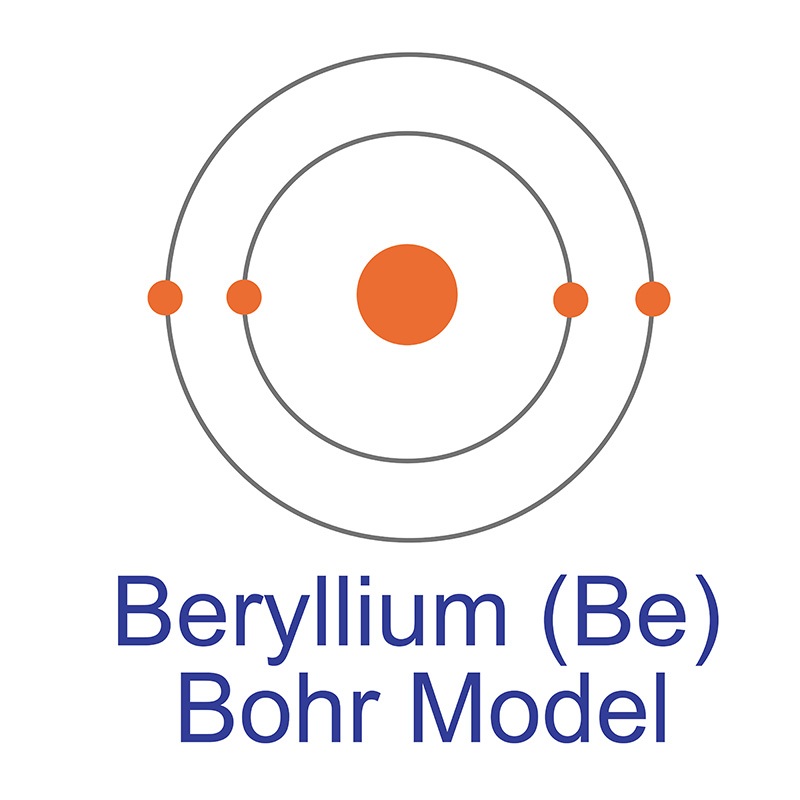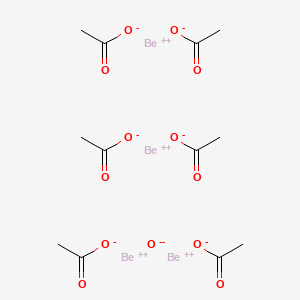SECTION 1. IDENTIFICATION
Product Name: Beryllium Acetate Basic
Product Number: All applicable American Elements product codes, e.g. BE-ACB-02
, BE-ACB-03
, BE-ACB-04
, BE-ACB-05
CAS #: 19049-40-2
Relevant identified uses of the substance: Scientific research and development
Supplier details:
American Elements
10884 Weyburn Ave.
Los Angeles, CA 90024
Tel: +1 310-208-0551
Fax: +1 310-208-0351
Emergency telephone number:
Domestic, North America: +1 800-424-9300
International: +1 703-527-3887
SECTION 2. HAZARDS IDENTIFICATION
Appearance: white powder
Warning! Causes eye, skin, and respiratory tract irritation. May cause allergic skin reaction. Cancer suspect agent.
Target Organs: Lungs, skin.


Potential Health Effects
Eye: Causes eye irritation. May cause chemical conjunctivitis.
Skin: Causes skin irritation. May cause skin sensitization, an allergic reaction, which becomes evident upon re-exposure to this material.
Ingestion: May cause gastrointestinal irritation with nausea, vomiting and diarrhea. The toxicological properties of this substance have not been fully investigated.
Inhalation: Causes respiratory tract irritation. The toxicological properties of this substance have not been fully investigated. Can produce delayed pulmonary edema.
Chronic: Effects may be delayed. Repeated or prolonged exposure may cause allergic reactions in sensitive individuals. Chronic beryllium disease, an immunologically mediated response occurring after a latent period ranging from a few weeks to many years, causes difficult breathing on exertion, weight loss, nonproductive cough, fatigue, chest pain, anorexia, and weakness. Cancer suspect agent.
SECTION 3. COMPOSITION/INFORMATION ON INGREDIENTS
19049-40-2 Beryllium acetate, basic
SECTION 4. FIRST AID MEASURES
Eyes: Immediately flush eyes with plenty of water for at least 15 minutes, occasionally lifting the upper and lower eyelids. Get medical aid.
Skin: Get medical aid. Flush skin with plenty of water for at least 15 minutes while removing contaminated clothing and shoes. Wash clothing before reuse.
Ingestion: Get medical aid. Do NOT induce vomiting. If conscious and alert, rinse mouth and drink 2-4 cupfuls of milk or water.
Inhalation: Remove from exposure and move to fresh air immediately. If not breathing, give artificial respiration. If breathing is difficult, give oxygen. Get medical aid. Do NOT use mouth-to-mouth resuscitation. If breathing has ceased apply artificial respiration using oxygen and a suitable mechanical device such as a bag and a mask.
Notes to Physician: Treat symptomatically and supportively.
SECTION 5. FIREFIGHTING MEASURES
General Information: As in any fire, wear a self-contained breathing apparatus in pressure-demand, MSHA/NIOSH (approved or equivalent), and full protective gear. During a fire, irritating and highly toxic gases may be generated by thermal decomposition or combustion.
Extinguishing Media: Use agent most appropriate to extinguish fire. Use water spray, dry chemical, carbon dioxide, or appropriate foam.
Flash Point: N/A
Autoignition Temperature: N/A
Explosion Limits, Lower:Not available.
Upper: Not available.
NFPA Rating: (estimated) Health: 2; Flammability: 0; Instability: 0
SECTION 6. ACCIDENTAL RELEASE MEASURES
General Information: Use proper personal protective equipment as indicated in Section 8.
Spills/Leaks: Vacuum or sweep up material and place into a suitable disposal container. Clean up spills immediately, observing precautions in the Protective Equipment section. Avoid generating dusty conditions. Provide ventilation.
SECTION 7. HANDLING AND STORAGE
Handling: Wash thoroughly after handling. Use with adequate ventilation. Minimize dust generation and accumulation. Avoid contact with eyes, skin, and clothing. Keep container tightly closed. Avoid ingestion and inhalation. Wash clothing before reuse.
Storage: Store in a tightly closed container. Store in a cool, dry, well-ventilated area away from incompatible substances. Poison room locked.
SECTION 8. EXPOSURE CONTROLS/PERSONAL PROTECTION
Engineering Controls: Facilities storing or utilizing this material should be equipped with an eyewash facility and a safety shower. Use adequate ventilation to keep airborne concentrations low.
Exposure Limits
Chemical Name ACGIH NIOSH OSHA - Final PELs
Beryllium acetate, basic 0.002 mg/m3 TWA (as Be) (listed under Beryllium compounds, n.o.s.).0.01 mg/m3 STEL (as Be) (listed under Beryllium compounds, n.o.s.). 4 mg/m3 IDLH (as Be) (listed under Beryllium compounds, n.o.s.). 2 æg/m3 TWA (listed under Beryllium compounds, n.o.s.).5 æg/m3 Ceiling (listed under Beryllium compounds, n.o.s.).
OSHA Vacated PELs: Beryllium acetate, basic: No OSHA Vacated PELs are listed for this chemical.
Personal Protective Equipment
Eyes: Wear appropriate protective eyeglasses or chemical safety goggles as described by OSHA's eye and face protection regulations in 29 CFR 1910.133 or European Standard EN166.
Skin: Wear appropriate protective gloves to prevent skin exposure.
Clothing: Wear appropriate protective clothing to prevent skin exposure.
Respirators: A respiratory protection program that meets OSHA's 29 CFR 1910.134 and ANSI Z88.2 requirements or European Standard EN 149 must be followed whenever workplace conditions warrant respirator use.
SECTION 9. PHYSICAL AND CHEMICAL PROPERTIES
Physical State: Powder
Appearance: white
Odor: none reported
pH: Not available.
Vapor Pressure: Not available.
Vapor Density: Not available.
Evaporation Rate:Not available.
Viscosity: Not available.
Boiling Point: 331 deg C
Freezing/Melting Point:284 deg C
Decomposition Temperature:Not available.
Solubility: Not available.
Specific Gravity/Density:1.3600g/cm3
Molecular Formula:C12H18O13Be4
Molecular Weight:406.32
SECTION 10. STABILITY AND REACTIVITY
Chemical Stability: Stable at room temperature in closed containers under normal storage and handling conditions.
Conditions to Avoid: Incompatible materials, dust generation, excess heat.
Incompatibilities with Other Materials: Oxidizing agents.
Hazardous Decomposition Products: Carbon monoxide, carbon monoxide, carbon dioxide.
Hazardous Polymerization: Has not been reported
SECTION 11. TOXICOLOGICAL INFORMATION
RTECS#:
CAS# 19049-40-2: DS2900000
LD50/LC50:
Not available.
Carcinogenicity:
CAS# 19049-40-2:
ACGIH: A1 - Confirmed Human Carcinogen (listed as 'Beryllium compounds, n.o.s.').
California: carcinogen, initial date 10/1/87 (listed as Beryllium compounds, n.o.s.).
NTP: Known carcinogen (listed as Beryllium compounds, n.o.s.).
IARC: Group 1 carcinogen (listed as Beryllium compounds, n.o.s.).
Epidemiology: Epidemiologic studies have demonstrated a statistically significant increase in lung cancer mortality in beryllium-exposed workers.
Teratogenicity: No information found
Reproductive Effects: No information found
Mutagenicity: No information found
Neurotoxicity: No information found
Other Studies:
SECTION 12. ECOLOGICAL INFORMATION
No data available.
SECTION 13. DISPOSAL CONSIDERATIONS
Chemical waste generators must determine whether a discarded chemical is classified as a hazardous waste. US EPA guidelines for the classification determination are listed in 40 CFR Parts 261.3. Additionally, waste generators must consult state and local hazardous waste regulations to ensure complete and accurate classification.
RCRA P-Series: None listed.
RCRA U-Series: None listed.
SECTION 14. TRANSPORT INFORMATION
Shipping Name: BERYLLIUM COMPOUNDS, N.O.S.
Hazard Class: 6.1
UN Number: UN1566
Packing Group: II
SECTION 15. REGULATORY INFORMATION
TSCA
CAS# 19049-40-2 is not listed on the TSCA inventory. It is for research and development use only.
Health & Safety Reporting List
None of the chemicals are on the Health & Safety Reporting List.
Chemical Test Rules
None of the chemicals in this product are under a Chemical Test Rule.
Section 12b
None of the chemicals are listed under TSCA Section 12b.
TSCA Significant New Use Rule
None of the chemicals in this material have a SNUR under TSCA.
CERCLA Hazardous Substances and corresponding RQs
None of the chemicals in this material have an RQ.
SARA Section 302 Extremely Hazardous Substances
None of the chemicals in this product have a TPQ.
SARA Codes
CAS # 19049-40-2: immediate, delayed.
Section 313
This material contains Beryllium acetate, basic (listed as Beryllium compounds, n.o.s.), 100%, (CAS# 19049-40-2) which is subject to the reporting requirements of Section 313 of SARA Title III and 40 CFR Part 373.
Clean Air Act:
CAS# 19049-40-2 (listed as Beryllium compounds, n.o.s.) is listed as a hazardous air pollutant (HAP).
This material does not contain any Class 1 Ozone depletors.
This material does not contain any Class 2 Ozone depletors.
Clean Water Act:
None of the chemicals in this product are listed as Hazardous Substances under the CWA.
None of the chemicals in this product are listed as Priority Pollutants under the CWA. CAS# 19049-40-2 is listed as a Toxic Pollutant under the Clean Water Act.
OSHA:
None of the chemicals in this product are considered highly hazardous by OSHA.
STATE
CAS# 19049-40-2 can be found on the following state right to know lists: California, (listed as Beryllium compounds, n.o.s.), New Jersey, (listed as Beryllium compounds, n.o.s.), Pennsylvania, (listed as Beryllium compounds, n.o.s.), Minnesota, (listed as Beryllium compounds, n.o.s.).
California Prop 65
The following statement(s) is(are) made in order to comply with the California Safe Drinking Water Act:
WARNING: This product contains Beryllium acetate, basic, listed as `Beryllium compounds, n.o.s.', a chemical known to the state of California to cause cancer.
California No Significant Risk Level: None of the chemicals in this product are listed.
SECTION 16. OTHER INFORMATION
Safety Data Sheet according to Regulation (EC) No. 1907/2006 (REACH). The above information is believed to be correct but does not purport to be all inclusive and shall be used only as a guide. The information in this document is based on the present state of our knowledge and is applicable to the product with regard to appropriate safety precautions. It does not represent any guarantee of the properties of the product. American Elements shall not be held liable for any damage resulting from handling or from contact with the above product. See reverse side of invoice or packing slip for additional terms and conditions of sale. COPYRIGHT 1997-2022 AMERICAN ELEMENTS. LICENSED GRANTED TO MAKE UNLIMITED PAPER COPIES FOR INTERNAL USE ONLY.
 The number of electrons in each of Beryllium's shells is [2, 2] and its electron configuration is [He] 2s2. The beryllium atom has a radius of 112 pm and a Van der Waals radius of 153 pm. Beryllium is a relatively rare element in the earth's crust; it can be found in minerals such as bertrandite, chrysoberyl, phenakite, and beryl, its most common source for commercial production. Beryllium was discovered by Louis Nicolas Vauquelin in 1797 and first isolated by Friedrich Wöhler and Antoine Bussy in 1828.
The number of electrons in each of Beryllium's shells is [2, 2] and its electron configuration is [He] 2s2. The beryllium atom has a radius of 112 pm and a Van der Waals radius of 153 pm. Beryllium is a relatively rare element in the earth's crust; it can be found in minerals such as bertrandite, chrysoberyl, phenakite, and beryl, its most common source for commercial production. Beryllium was discovered by Louis Nicolas Vauquelin in 1797 and first isolated by Friedrich Wöhler and Antoine Bussy in 1828.  In its elemental form, beryllium has a gray metallic appearance. It is a soft metal that is both strong and brittle; its low density and high thermal conductivity make it useful for aerospace and military applications. It is also frequently used in X-ray equipment and particle physics. The origin of the name Beryllium comes from the Greek word "beryllos," meaning beryl.
In its elemental form, beryllium has a gray metallic appearance. It is a soft metal that is both strong and brittle; its low density and high thermal conductivity make it useful for aerospace and military applications. It is also frequently used in X-ray equipment and particle physics. The origin of the name Beryllium comes from the Greek word "beryllos," meaning beryl.

